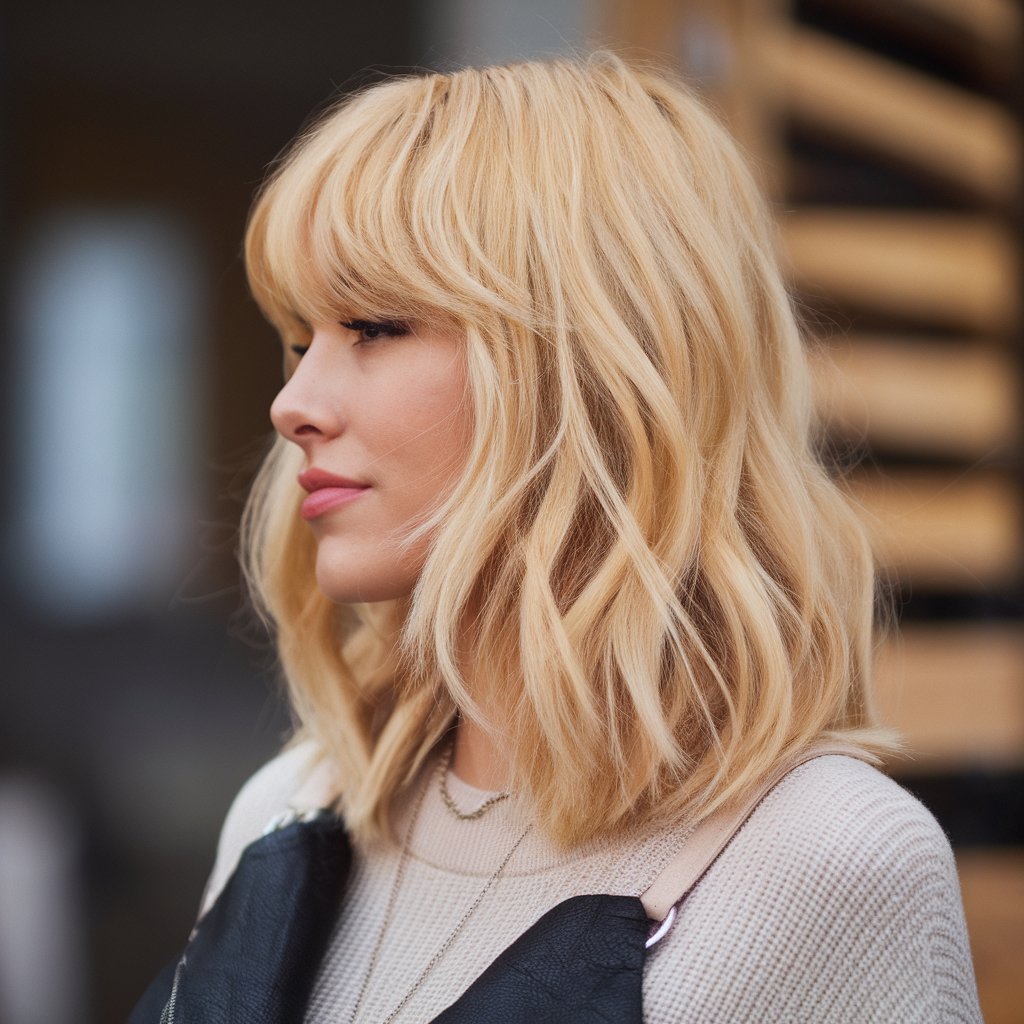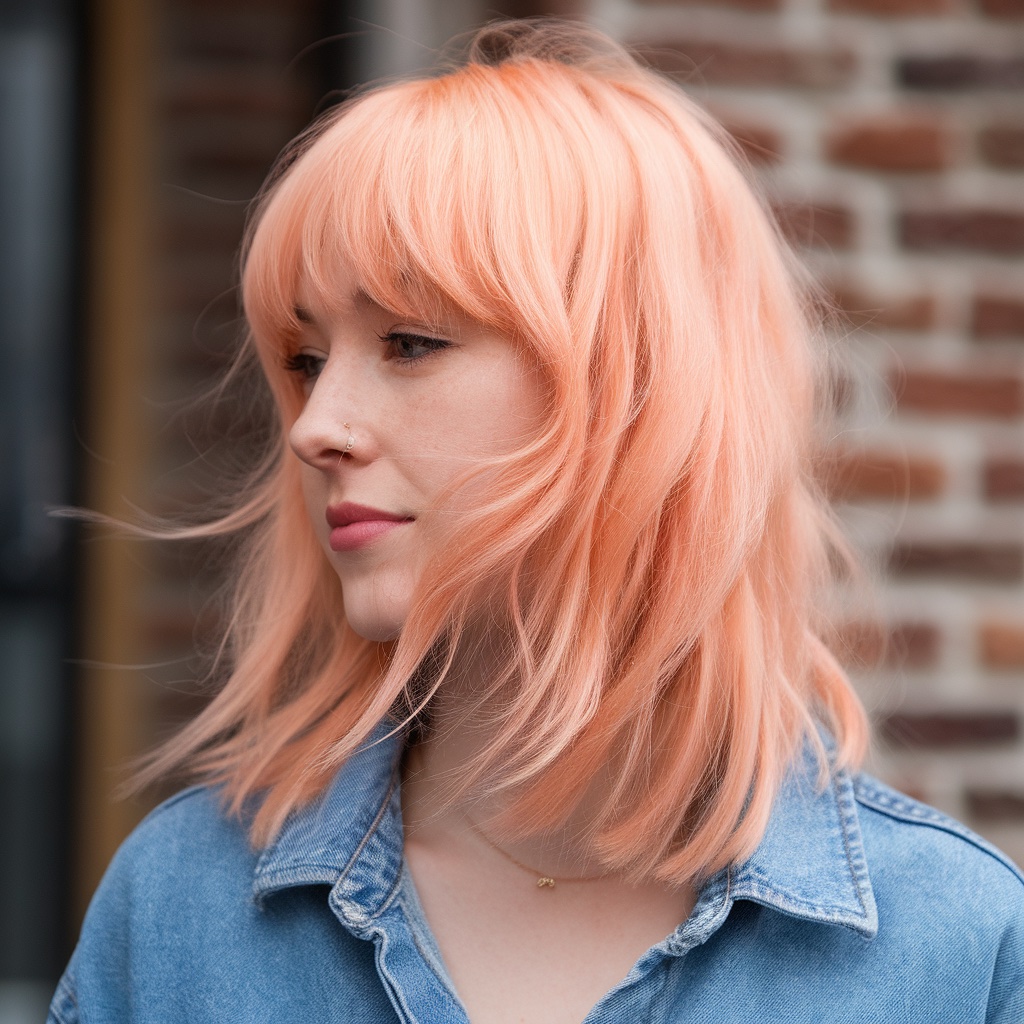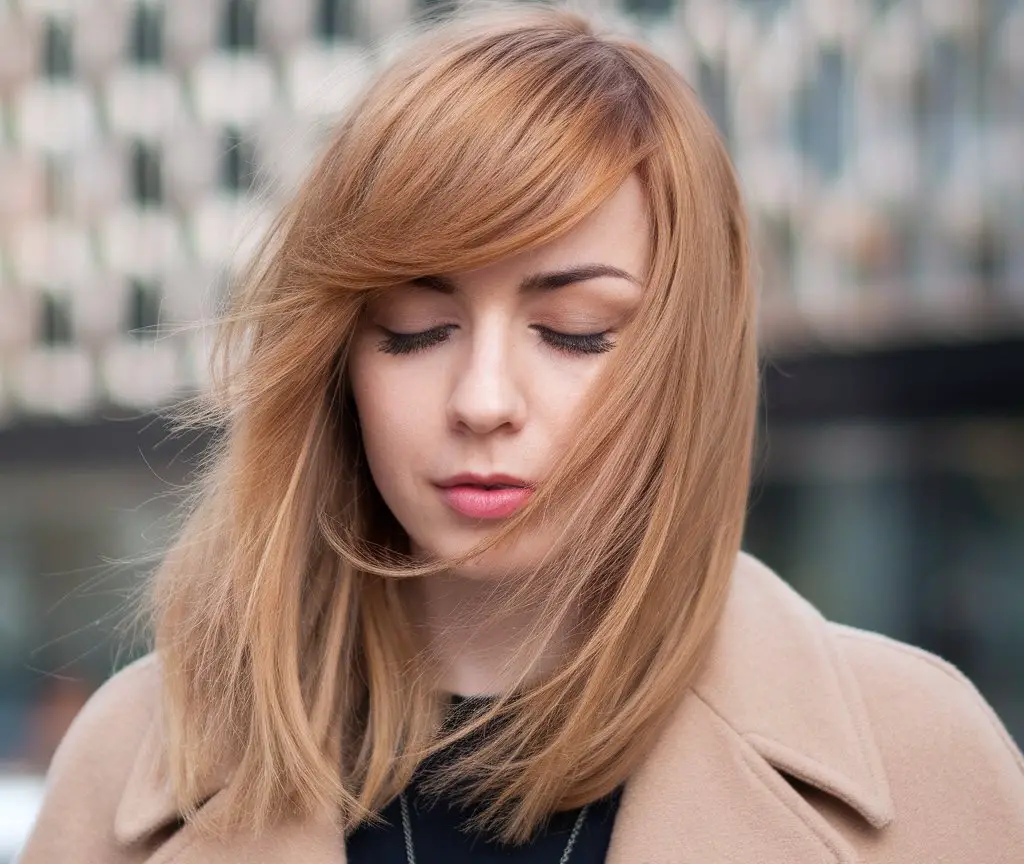Fringe and bangs can transform your look in an instant. These face-framing hair styles add personality and flair to any haircut. Many women love the idea of sporting fringe or bangs but hesitate to visit the salon for every trim. The good news? You can learn to cut and maintain your own fringe at home.
Cutting your own fringe offers several advantages. It saves time and money on frequent salon visits. You can also adjust your style whenever you want, experimenting with different lengths and shapes. Plus, you’ll gain a new skill that allows you to keep your hair looking fresh between professional cuts.
In the following sections, we’ll share everything you need to know about cutting fringe and bangs. We’ll cover the differences between these styles, how to choose the right one for your face shape, and popular fringe trends. You’ll also learn about proper preparation, step-by-step cutting techniques, and maintenance tips. Ready to take control of your hair? Let’s go!
- What's the difference between fringe and bangs?
- Which fringe style suits your face shape?
- What are the most popular fringe and bang styles?
- How do you prepare your hair for cutting fringe?
- What's the step-by-step process for cutting fringe?
- How can you maintain and style your new fringe?
- Fringe Benefits: Your Path to Fabulous Hair
- Frequently Asked Questions
What’s the difference between fringe and bangs?

Fringe and bangs are often used interchangeably, but they have subtle differences. Understanding these distinctions can help you choose the right style for your face and personal taste. Let’s explore the world of these popular hair trends and uncover what sets them apart.
Defining fringe
Fringe typically refers to a softer, more textured look. It’s characterized by longer strands that blend seamlessly into the rest of your hair. This style often appears more natural and can be swept to the side or parted in the middle. Fringe tends to be more versatile, allowing for various styling options.
Why choose fringe? It offers a low-maintenance option for those who want to change their look without committing to a dramatic cut. Fringe can be easily grown out or styled differently if you decide it’s not for you.
Explaining bangs
Bangs, on the other hand, are usually shorter and more defined. They sit straight across the forehead and are often cut in a blunt line. This style makes a bold statement and can dramatically change your appearance. Bangs require more frequent trims to maintain their shape and length.
Are bangs right for you? Consider your lifestyle and willingness to style your hair daily. Bangs can be a great way to highlight your eyes or conceal a high forehead, but they do require some upkeep.
Regional terminology variations
Interestingly, the terms “fringe” and “bangs” can mean different things depending on where you are in the world. In the United Kingdom and some other English-speaking countries, “fringe” is the common term for what Americans call “bangs.” This regional variation can lead to some confusion when discussing hairstyles internationally.
Here’s a quick guide to regional terms:
- USA: Bangs
- UK: Fringe
- Australia: Fringe
- Canada: Both terms are used
Face-framing effects
Both fringe and bangs can have a significant impact on how your face is perceived. They can soften angular features, highlight cheekbones, or even make your face appear more oval. The key is choosing the right style for your face shape.
For example, side-swept fringe can elongate a round face, while straight-across bangs can balance out a long face. Experimenting with different styles can help you find the most flattering look for your unique features.
Styling versatility
One of the biggest advantages of fringe and bangs is their styling versatility. You can change up your look without committing to a full haircut. From sleek and straight to tousled and textured, the possibilities are endless.
Try pinning your fringe back for a different look, or use a curling iron to add some waves. With bangs, you can experiment with different partings or even braid them for a fun, bohemian vibe.
Ultimately, the choice between fringe and bangs comes down to personal preference and your individual hair type. Both styles can add a fresh, youthful element to your look and frame your face beautifully. Whether you opt for the softer, more blended appearance of fringe or the bold statement of bangs, you’re sure to turn heads with your new style.
Which fringe style suits your face shape?

Choosing the right fringe style can enhance your natural features and complement your face shape. The perfect fringe can balance your proportions, highlight your best attributes, and even create the illusion of a different face shape. Let’s explore how to select the most flattering fringe for various face shapes.
Round face considerations
If you have a round face, your goal is to create the illusion of length and definition. Opt for fringe styles that elongate your face and add angles. A side-swept fringe that hits at the cheekbones can help slim your face. Avoid blunt, straight-across bangs as they can make your face appear wider.
Try these fringe styles for round faces:
- Long, side-swept fringe
- Curtain bangs that part in the middle
- Wispy, textured fringe
Oval face options
Oval faces are often considered the most versatile when it comes to hairstyles. You can pull off almost any fringe style, so feel free to experiment. However, to maintain the balance of your face shape, avoid overly heavy or blunt bangs that might shorten the appearance of your face.
What fringe styles work best for oval faces? You have plenty of options:
- Blunt, straight-across bangs
- Side-swept fringe
- Curtain bangs
- Choppy, textured fringe
Square face recommendations
Square faces are characterized by strong jawlines and broad foreheads. The key is to soften these angular features with your fringe choice. Rounded or curved fringe styles can help balance the squareness of your face.
For square faces, consider these fringe styles:
- Soft, wispy bangs
- Rounded, eyebrow-grazing fringe
- Side-swept bangs that curve at the cheekbones
Avoid straight, blunt bangs that hit at the jawline, as they can accentuate the squareness of your face.
Heart-shaped face suggestions
Heart-shaped faces typically have wider foreheads and narrower chins. Your fringe should aim to balance these proportions. Styles that add width to the lower part of your face can be particularly flattering.
Here are some fringe ideas for heart-shaped faces:
- Side-swept bangs that curve towards the cheekbones
- Curtain bangs that frame the face
- Choppy, textured fringe that hits just below the eyebrows
Steer clear of blunt, straight-across bangs that might emphasize the width of your forehead.
Long face fringe ideas
If you have a long face, your goal is to create the illusion of width and shorten the appearance of your face. Horizontal lines created by your fringe can help achieve this effect.
Try these fringe styles to complement a long face:
- Full, blunt bangs that hit at or just below the eyebrows
- Thick, side-swept fringe
- Rounded bangs that curve at the temples
Avoid very long or wispy bangs, as they can elongate your face further.
Remember, these guidelines are just starting points. Your hair texture, personal style, and lifestyle should also factor into your fringe choice. Don’t be afraid to consult with a hairstylist who can provide personalized recommendations based on your unique features and preferences.
Experimenting with different fringe styles can be a fun way to refresh your look without committing to a drastic change. Whether you opt for bold, blunt bangs or a soft, side-swept fringe, the right style can frame your face beautifully and boost your confidence.
What are the most popular fringe and bang styles?

Fringe and bang styles have become increasingly popular, offering a quick way to refresh your look without a major haircut. These face-framing options can highlight your best features and add personality to your hairstyle. Let’s explore some of the most sought-after styles that have caught the attention of women everywhere.
Side-swept fringe
The side-swept fringe is a classic choice that never goes out of style. This versatile option suits various face shapes and hair textures. It’s characterized by longer strands that sweep across the forehead, typically angled from one side to the other.
Why choose a side-swept fringe? It offers a soft, feminine look that can be easily styled. You can wear it sleek and straight for a polished appearance or tousle it for a more casual vibe. This style is particularly flattering for those with round or square faces, as it creates the illusion of length.
Styling tip: Use a round brush while blow-drying to create a gentle curve in your fringe. This will help it fall naturally to the side.
Curtain bangs
Curtain bangs have surged in popularity recently, and for good reason. This style features a center part with longer strands that frame both sides of the face, resembling curtains. They blend seamlessly with the rest of your hair, creating a soft, effortless look.
What makes curtain bangs so appealing? They’re incredibly versatile and low-maintenance. You can style them to be more or less prominent depending on your mood or the occasion. They work well with various hair lengths and textures, from short bobs to long, flowing locks.
Here are some ways to style curtain bangs:
- Blow-dry them away from your face for a voluminous look
- Pin them back for a chic updo
- Let them air-dry for a relaxed, beachy vibe
Blunt bangs
For those seeking a bold, eye-catching style, blunt bangs are the way to go. This striking look features straight-across bangs that typically sit at or just above the eyebrows. They create a strong horizontal line across the forehead, adding drama to any hairstyle.
Blunt bangs can make a powerful statement, drawing attention to your eyes and cheekbones. They work particularly well with straight hair but can also complement wavy or curly textures with the right styling techniques.
Keep in mind that blunt bangs require regular trims to maintain their sharp edge. They also tend to show oil more quickly than other styles, so dry shampoo might become your new best friend.
Wispy fringe
If you’re looking for a softer, more subtle option, wispy fringe might be perfect for you. This style features light, feathery strands that gently frame the face. Wispy fringe is less committal than other bang styles and can be easily blended into your existing haircut.
One of the main advantages of wispy fringe is its versatility. You can wear it straight down, sweep it to the side, or even pin it back when you want a change. It’s an excellent choice for those new to bangs or anyone who wants a low-maintenance option.
Styling suggestion: Use a small round brush to add volume at the roots while blow-drying. This will give your wispy fringe a bit of lift and movement.
Textured bangs
Textured bangs offer a playful, edgy alternative to more traditional styles. This look incorporates various lengths and layers within the bangs, creating depth and movement. Textured bangs can add interest to straight hair and enhance the natural pattern of wavy or curly locks.
One of the benefits of textured bangs is their forgiving nature. The varied lengths mean they grow out more naturally than blunt styles, requiring less frequent trims. They also allow for more styling flexibility – you can wear them messy and tousled or smooth them out for a sleeker appearance.
To style textured bangs, try using a texturizing spray or dry shampoo to enhance their piece-y look. You can also use a flat iron to create subtle bends and waves for added dimension.
Choosing the right fringe or bang style is a personal decision that depends on your face shape, hair texture, and personal style. Don’t be afraid to experiment with different options to find the one that makes you feel most confident and comfortable. Remember, hair grows back, so have fun exploring these popular styles and finding the perfect fringe for you.
How do you prepare your hair for cutting fringe?

Preparing your hair for a fringe cut is a crucial step in achieving the look you desire. The right preparation can make the difference between a stunning new style and a hair mishap. Let’s explore the essential steps to get your hair ready for that perfect fringe.
Washing and drying techniques
Clean hair is the foundation of any good haircut. But how should you wash your hair before cutting fringe? Here are some tips to get you started:
- Use a gentle shampoo and conditioner to clean your hair thoroughly.
- Opt for lukewarm water to maintain moisture levels and avoid heat damage.
- Gently towel-dry your hair without rubbing vigorously.
- Allow your hair to air dry or use a blow dryer on low heat.
These steps help keep your hair healthy and manageable for cutting. Clean, well-conditioned hair is easier to work with and will give you a more accurate idea of how your fringe will look once styled.
Sectioning the hair properly
Once your hair is clean and dry, it’s time to section it properly. This step is crucial for achieving an even, well-balanced fringe. How do you section your hair for a fringe cut? Let’s break it down:
- Part your hair down the middle or on the side, based on your preference.
- Use clips to secure the upper sections of your hair, leaving the fringe area loose.
- If you have thick hair, divide the loose section into smaller parts for more precise cutting.
Proper sectioning allows you to focus on the fringe area without interference from the rest of your hair. It also helps you maintain control over the amount of hair you’re cutting, preventing accidental over-trimming.
Determining the right length
Choosing the right length for your fringe is a personal decision that depends on your face shape, hair texture, and personal style. However, there are some general guidelines you can follow:
- Consider your face shape and personal style when deciding on length.
- Start with a longer length – you can always trim more if needed.
- Use a comb to bring the hair down to your desired length before cutting.
Remember, it’s always better to err on the side of caution and cut less initially. You can always trim more, but you can’t add length back once it’s cut.
Choosing the correct cutting angle
The angle at which you cut your fringe can significantly impact its final look. A slight angle can create a softer, more blended appearance, while a straight-across cut results in a more dramatic look. Here’s how to choose and maintain the right angle:
- Hold the hair at a slight angle while cutting, rather than straight across.
- This angled approach helps blend the fringe with the rest of your hair.
- Experiment with different angles to find what works best for your hair type and desired style.
The right cutting angle can make your fringe look more natural and easier to style. It’s worth taking the time to find the angle that works best for you.
Gathering necessary tools and products
Before you start cutting, make sure you have all the necessary tools at hand. Having the right equipment can make the process smoother and more efficient. Here’s a list of essential items for cutting fringe:
- Sharp hair scissors for precise cutting
- A fine-tooth comb to smooth the hair before cutting
- Clips to section the hair appropriately
- A spray bottle with water to dampen the hair if needed
- A mirror for clear visibility during the cut
Having these tools ready before you start will help you avoid interruptions and maintain focus during the cutting process.
Preparing your hair for a fringe cut involves several steps, from washing and drying to gathering the right tools. By following these guidelines, you’ll set yourself up for success in achieving the fringe of your dreams. Remember, practice makes perfect, so don’t be discouraged if your first attempt isn’t flawless. With time and experience, you’ll become more confident in your fringe-cutting skills.
What’s the step-by-step process for cutting fringe?

Cutting your own fringe can be an exciting yet nerve-wracking experience. With the right approach and techniques, you can achieve a professional-looking result at home. Let’s walk through the process step by step, focusing on key elements that will help you create the perfect fringe for your face.
Sectioning the hair correctly
The first step in cutting fringe is proper sectioning. This crucial step sets the foundation for your entire cut. Start by washing and drying your hair as you normally would. Then, follow these steps:
- Part your hair as you typically wear it.
- Identify the area where you want your fringe to start and end.
- Use a comb to create a triangle section at the front of your head.
- Secure the rest of your hair with clips or hair ties.
Why is correct sectioning so important? It helps you focus on the specific area you’re cutting, preventing accidental snips in unwanted places. It also allows you to maintain control over the shape and length of your fringe.
Determining the ideal length
Now that you’ve sectioned your hair, it’s time to decide on the length. This decision depends on various factors, including your face shape, hair texture, and personal preference. Here’s a quick guide to help you choose:
- For round faces: Longer, side-swept fringe can help elongate your face.
- For square faces: Softer, wispy fringe can balance strong jawlines.
- For oval faces: You have the flexibility to try various lengths.
- For heart-shaped faces: Longer fringe that hits at the cheekbones can be flattering.
Remember, it’s always better to start longer and gradually trim shorter. You can always cut more, but you can’t add length back once it’s gone.
Holding scissors properly
Proper scissor technique is essential for achieving a clean, even cut. How you hold your scissors can significantly impact the outcome of your fringe. Follow these tips for optimal control:
- Hold the scissors with your dominant hand.
- Place your thumb in one handle and your ring finger in the other.
- Rest your index and middle fingers on the outer blade for stability.
- Keep your pinky finger free for balance.
This grip allows for precise movements and helps prevent accidental cuts or uneven lengths. Practice opening and closing the scissors in this position before you start cutting to get comfortable with the motion.
Cutting techniques for different styles
Different fringe styles require different cutting techniques. Let’s explore some popular styles and how to achieve them:
- Blunt fringe: Cut straight across for a bold, dramatic look.
- Side-swept fringe: Cut at a slight angle, longer on one side.
- Curtain fringe: Create a center part and cut each side at an angle, longer towards the cheeks.
- Wispy fringe: Use point cutting (holding scissors vertically) for a softer edge.
Whichever style you choose, start by cutting small amounts at a time. It’s easier to trim more later than to fix a fringe that’s too short.
Blending the fringe with rest of hair
The final step in cutting fringe is blending it with the rest of your hair for a seamless look. This process helps your new fringe appear natural and intentional. Here are some techniques to try:
- Use thinning shears to soften the edges of your fringe.
- Point cut the ends to create texture and remove any blunt lines.
- Gently twist small sections of your fringe and snip the ends for a piece-y effect.
After blending, style your fringe as desired. You might need to use a round brush and blow dryer to achieve the perfect shape and direction.
Cutting your own fringe can be a rewarding experience. It allows you to refresh your look without a full haircut and saves time and money on salon visits. With practice, you’ll become more confident in your ability to maintain and style your fringe at home. Remember, hair grows back, so don’t be afraid to experiment and find the perfect fringe style for you.
How can you maintain and style your new fringe?

Your new fringe can be a game-changer for your overall look, but it requires proper care and styling to maintain its charm. Let’s explore some practical ways to keep your fringe looking fresh and fabulous every day.
Daily styling tips
Styling your fringe daily doesn’t have to be a time-consuming task. With a few simple techniques, you can achieve a polished look in minutes. Start by washing your fringe separately from the rest of your hair. This allows you to refresh it without washing your entire head. Use a small round brush while blow-drying to create the desired shape and direction.
For a sleek look, try this quick routine:
- Dampen your fringe slightly
- Apply a small amount of styling cream
- Use a flat iron to smooth it out
- Finish with a light-hold hairspray
If you prefer a more natural, textured look, try scrunching your fringe with your fingers while blow-drying on a low heat setting. This creates a soft, piece-y effect that’s perfect for casual days.
Recommended products for fringe care
The right products can make a significant difference in how your fringe looks and feels. A lightweight leave-in conditioner can help keep your fringe soft and manageable without weighing it down. Dry shampoo is another must-have for fringe maintenance. It absorbs excess oil and adds volume, perfect for refreshing your look between washes.
Consider adding these items to your hair care arsenal:
- Texturizing spray for added body and hold
- Heat protectant to shield your fringe from styling damage
- Smoothing serum to tame flyaways and add shine
Remember, a little product goes a long way with fringe. Start with small amounts and build up as needed to avoid a greasy or weighed-down appearance.
Dealing with cowlicks and unruly hair
Cowlicks and stubborn hair can be particularly challenging when it comes to fringe. These pesky hair patterns often seem to have a mind of their own. However, there are ways to tame them. One effective method is to train your hair over time. Consistently style your fringe in the desired direction, and eventually, it will start to cooperate.
For immediate results, try these tricks:
- Use a strong-hold gel on damp hair
- Blow-dry your fringe in the opposite direction of the cowlick
- Finish by blow-drying in the desired direction
- Set with a cool shot from your dryer
If all else fails, consider incorporating the cowlick into your style. Sometimes, working with your hair’s natural tendencies can create a unique and effortless look.
Trimming frequency advice
Regular trims are crucial for maintaining the shape and length of your fringe. How often should you trim? It depends on how fast your hair grows and the specific style of your fringe. On average, most women find that trimming every 2-3 weeks keeps their fringe looking fresh.
If you’re comfortable with scissors, you can maintain your fringe at home between salon visits. Here’s a simple method:
- Section off your dry, styled fringe
- Hold small sections between your fingers
- Trim just the ends, cutting vertically for a softer look
- Check for evenness and adjust as needed
Remember, it’s always better to cut less than you think you need. You can always trim more, but you can’t add length back once it’s cut.
Growing out fringe gracefully
Decided to grow out your fringe? This process can be frustrating, but with the right approach, you can transition gracefully. The key is to have a plan and be patient. Start by letting the sides of your fringe grow longer while maintaining the center at your desired length. This creates a face-framing effect that blends well with the rest of your hair.
As your fringe grows, try these styling options:
- Pin it back with cute hair accessories
- Braid it and incorporate it into your hairstyle
- Use a texturizing product to blend it with longer layers
Don’t forget to trim the ends regularly, even as you’re growing it out. This prevents split ends and keeps your hair looking healthy throughout the transition.
Maintaining and styling your new fringe doesn’t have to be complicated. With these tips and tricks, you can keep your fringe looking fresh and stylish every day. Experiment with different products and techniques to find what works best for your hair type and lifestyle. Your fringe is a versatile feature that can elevate your overall look, so have fun with it and let your personal style shine through.
Fringe Benefits: Your Path to Fabulous Hair
Cutting and maintaining your own fringe can be a rewarding experience that allows you to refresh your look without a full haircut. With the right techniques and tools, you can achieve professional-looking results at home. From selecting the perfect style for your face shape to mastering the art of daily styling, your fringe can become a versatile and expressive part of your overall appearance.
Remember that practice makes perfect when it comes to fringe care. Don’t be afraid to experiment with different products and styling methods to find what works best for you. Whether you’re rocking a bold blunt bang or a soft side-swept fringe, your new look is an opportunity to showcase your personality and boost your confidence. Embrace the journey of fringe maintenance, and enjoy the transformative power of this simple yet impactful hairstyle choice.
Frequently Asked Questions
Q: How often should I trim my fringe?
A: On average, trimming your fringe every 2-3 weeks helps maintain its shape and length.
Q: What’s the best way to deal with a cowlick in my fringe?
A: Try blow-drying your fringe in the opposite direction of the cowlick, then in the desired direction, and set with a cool shot from your dryer.
Q: Can I wash just my fringe without washing all my hair?
A: Yes, you can wash your fringe separately to refresh it without washing your entire head.
Q: What products are essential for fringe care?
A: Essential products include lightweight leave-in conditioner, dry shampoo, and heat protectant.
Q: How do I choose the right fringe style for my face shape?
A: Consider your face shape: longer, side-swept fringe for round faces, softer fringe for square faces, and various lengths for oval faces.
Q: What’s the best way to grow out my fringe?
A: Let the sides grow longer while maintaining the center, and use accessories or braiding to blend it with longer hair.
Q: How do I cut my own fringe at home?
A: Section your dry, styled fringe, hold small sections between your fingers, and trim just the ends, cutting vertically for a softer look.
Q: What’s the difference between fringe and bangs?
A: Fringe typically refers to a softer, more textured look, while bangs are usually shorter and more defined.
Q: How can I style my fringe quickly in the morning?
A: Use a small round brush while blow-drying to create the desired shape and direction, or scrunch with your fingers for a more natural look.

